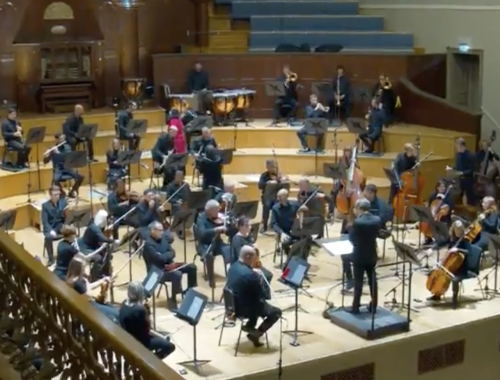THE MAC THEATRE: Learning, Limelighting, Longing.
How work placement in The Mac helped me overcome creative and self-inflicted obstacles


Over the past two years theatre doors have been shut, instead we were introduced to a new scope of theatre, a new lens through the medium of platforms such as Zoom. Instead of dressing up and lining up outside an auditorium, we got our pyjamas on and sat on our sofas. Now with restrictions easing, and theatre doors finally being swung open we have been given the opportunity to return to normality as Drama students. As part of our final year of study we get to embark on a work placement journey to enhance our existing skills and learn new ones along the way. My work placement in The MAC has been extremely awakening in terms of everything that goes on behind the scenes of a theatre and gave me a glimpse of what a career in theatre will possibly look like. I got to see many different areas as; “change is constant in the creative industries,”[1] and The MAC is home to so many kinds of artists.
I will use Gibb’s Reflective cycle as a means of evaluation throughout the first few week of my 100-hour placement.
Family Room and the fight for housing equality.


The MAC often works with local artists and houses their work for a long period of time across their three galleries. When I began my placement, the artist was Anne Tallentire and her work ‘But this material…’. It was reimagined for The MAC and the pieces; “explore how we inhabit space, both public and private, to reveal systems that shape the build environment and the economics of labour,”[2] in other words it’s her interrogation of everyday materials and how structures are developed. Running concurrently with her work are screenings, talks, and workshops with more information on the lack of social housing in Belfast. These are in partnership with Participation & Practice of Right (PPR) are a “human rights NGO with a big vision: to turn international human rights standards into grassroots tools for economic, social and environmental change.”[3] In addition to these workshops, my supervisor decided she wanted to use the derelict family room and turn it into a children’s workshop where they can learn more about issues highlighted in the exhibition. We had meetings at the beginning of the week, which initially I felt nervous about as it was something I had never done before, I shocked myself with the input I made and how some of the suggestions I made were taken on board which led to some independent research. Our main concern was the colour scheme, we didn’t want anything too abrupt or loud as this may have led to some sensory issues with children, we used calm blues, pinks, and greens as the main colour scheme to still lighten the room and make it inviting. Since The MAC holds 3 galleries, we also wanted the children to know what an artist is and how their work goes about being displayed hence the development of their own gallery wall where they can display their work based on Anne Tallentire’s work. The evolution of this family room required both teamwork, and independent research, it took just over 3 weeks to complete and throughout the process I learned about formality in meetings and how creative learning teams can create something both educational and entertaining for children. I now have a deeper understanding of behind-the-scenes administrative running of a theatre and it is most certainly a knowledge I can bring on to my next work journey post-graduation.
Fly the Flag and Filming.


Another project The MAC was facilitating was the Fly the Flag project which sought out young dancers who are passionate about making a change in the world by sharing ideas on environmental, societal, or basic human rights freely, without fear of discrimination. It is a nationwide project led by some of the world’s leading choreographers such as Oona Doherty and Rosie Mullan. Once rehearsals concluded there was a day of filming, which required us to walk around different shoot locations making sure the lighting, background and space was suitable. This was arguably my favorite day of placement as filming is something I’ve always been interested in, and seeing how the set-up of cameras work, the co-ordination of the whole team, and how everyday will be different reaffirmed this interest. As a theatre student I have grown to understand that; “the media landscape has changed rapidly since the 1980s when at home entertainment took over.”[4] This is why I never shut film/television out as a potential pathway for myself. This experience thus reminded me of my profound interest in cinematography, and since then, I have charged up my old camera and tried to go out at least 3 times a week and refresh the old skill I hadn’t revisited in months. I hope to keep this up and possibly go into this career path further down the line.
Setting up and staging my future.
This work experience has taught me many things; my ability to be proactive and take initiative has been enhanced as I was often given independence to look after certain things, such as the family room, ensuring each week there was supplies for the workshop that takes place at the weekend. There was an aspect of shadowing at The MAC, when I would go to meetings with my supervisor, however, as mentioned before I often shocked myself with the input I gave and how it was taken on board, this is something I never would’ve thought I would be able to do. Arguably the toughest thing about this placement, was juggling the workload and responsibility between The MAC, and university work. I didn’t want to let myself fall behind in either, but with good organisational and time-management skills I ensured I kept this to a minimum.
The most valuable thing about this experience was getting to meet all the different kinds of people that ensure the theatre runs. I offered to help out after hours to allow myself to meet people behind The MAC, after all; “one of the key ways you can build your network is by putting yourself forward”[5] in this competitive job market
[1] Rosamund Davies and Gauti Sigthorsson, Introducing the creative industries. (London: SAGE, 2013) p.217.
[2] The MAC. 2021. Anne Tallentire: But this Material…. [online] Available at: <https://themaclive.com/exhibition/anne-tallentire-but-this-material#tab2> [Accessed 18 October 2021].
[3] Participation and the Practice of Rights. 2021. About Us | PPR | No-one Left Behind. [online] Available at: <https://www.nlb.ie/about> [Accessed 18 October 2021].
[4] Georgina Gregory, Ewa Mazierska and Ros Healy, Careers In Media And Film (New York: SAGE Publications Ltd, 2007), p. 16.
[5] Georgina Gregory, Ewa Mazierska and Ros Healy, Careers In Media And Film (New York: SAGE Publications Ltd, 2007), p. 60
BIBLIOGRAPHY:
Davies, R. and Sigthorsson, G. Introducing the creative industries. (London: SAGE, 2013).
Gregory, G, Mazierska, E and Healy, R, Careers In Media and Film, (New York: SAGE Publications Ltd, 2007).
Participation and the Practice of Rights. About Us | PPR | No-one Left Behind, 2021. Available at: <https://www.nlb.ie/about> [accessed 18 October 2021]
The MAC, Anne Tallentire: But this Material…., 2021, Available at: <https://themaclive.com/exhibition/anne-tallentire-but-this-material#tab2> [accessed 18 October 2021]
You May Also Like

Breaking into the Film Industry: What You Know or Who You Know?
24 November 2021
First Day Fears
24 November 2021
